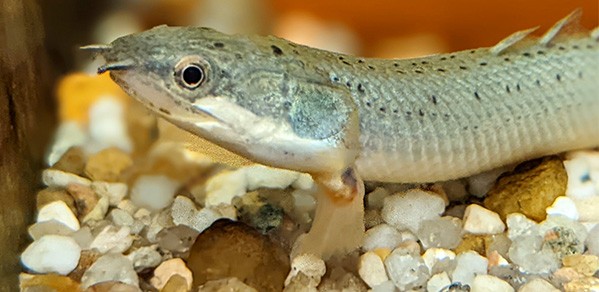
Cambridge engineers will build a ‘robofish’ as part of a collaborative research project exploring the water-to-land transition of the ‘walking fish’ population.
We will apply biomimetic engineering methods to gain further insights into the biomechanics and evolutionary biology of this 'walking fish'.
Professor Fumiya Iida
The research, due to begin this autumn, will provide the first energetics explanation to better understand why some fishes walk underwater, and to identify the anatomical traits and mechanisms that enabled vertebrates to transition from water to land more than 370 million years ago.
A bio-inspired soft robotic model, capable of both walking and swimming, will be used to replicate the fin anatomy and body of a living primitive African fish called a bichir (Polypterus senegalus). This fish can breathe air and ‘walk’ on land using two front fins.
For the purpose of the research, the bichirs will be reared both underwater and in a semi-terrestrial environment where there are different loose materials to traverse, both flat and complex 3D structures. This is so researchers can better understand the adaptive locomotor performance of the fish across different terrains and environments. To quantify locomotor performance from a purely mechanical point of view, the researchers will construct a bio-inspired robotic platform.
Fumiya Iida, Professor of Robotics in the Department’s Bio-Inspired Robotics Laboratory, is co-principal investigator of the project titled The walking fish: Integrating biomechanics, energetics and robotics to study water-land transition. Professor Iida will work closely with the PI Dr Valentina Di Santo, from Stockholm University, and co-PI Professor Neil Shubin, from the University of Chicago. The project has been awarded a research grant from the International Human Frontier Science Program Organization (HFSPO), following a year-long global selection process.
The robotic platform will be validated against experiments using different walking fishes. It will consist of rigid skeletal components, soft deformable layers and a compartment accommodating electronic components such as sensors, motors and microcontrollers.
“The main technological challenge lies in the design and construction of biologically plausible soft-rigid structures that mimic Polypterus musculoskeletal dynamics,” said Professor Iida.
“Our ‘robofish’ will be trained to understand the relationship between mechanical features and how they interact with motor patterns to form adaptive behaviours over different substrates at different body sizes. The performance of the ‘robofish’ will be compared to that of real fish under different environmental conditions. We will then be able to model the movement of existing and extinct species of ‘walking fish’ and their closest relatives.
“Data from our project will produce new robotic solutions to construct artificial amphibious platforms for explorations in transitional areas where adaptability is necessary.”
Dr Di Santo, Assistant Professor of Functional Morphology at Stockholm University, said: “We want to answer a fundamental question in evolutionary physiology and biomechanics which is why some fishes walk underwater. Underwater walking preceded the water-land transition in vertebrates, and some species prefer to walk rather than swim underwater. We want to understand the mechanisms underlying this locomotor behaviour to lay out the morphological and physiological characteristics necessary to walk with fins.”
Professor Shubin, Robert R. Bensley Distinguished Service Professor of Anatomy at the University of Chicago, said: “The origin of walking in fish was one of the major events in the history of life. Without it, fish never would have made the transition from water to land. In a very real sense, we wouldn’t be here if not for this evolutionary change in fish.”

